Yes, I know your Beer Can Chicken tastes wonderful. Yes, it is moist and flavorful. Yes, I know your neighbors and family think your Beer Can Chicken is fabulous. It absolutely positively is fabulous. What’s not to love about roast chicken?
Yes, I know there are two books on Beer Can Chicken Recipes, a blog about Beer Can Chicken, a Kenny Chesney song on the subject, millions of devotees, and scores of gadgets to assist the process. Yes, with the fowl perched comically on its legs seemingly guzzling brew through its posterior, Beer Can Chicken is a showstopper.
But Beer Can Chicken remains a gimmick, an inferior cooking technique, a waste of good beer, and it is potentially hazardous (click to Tweet this).
Think about this: You’ve never seen a fine dining restaurant serve Beer Can Chicken, have you? That’s because professional chefs know this is clearly not the best way to roast a chicken.
In the words of Sterling Ball of BigPoppaSmokers.com “I think Beer Can Chicken is a religion. We need a little separation of faith and science here.”
Video: Meathead debunks the myth of beer can chicken
Watch me hit the highpoints on the Food Network. But before you scroll down and call me an idiot, please read on and gather the facts.
Audio: Meathead debunks the myth of beer can chicken on NPR
Hear me on Science Friday on NPR discuss the subject in more detail:
First, let’s look at what beer can chicken gets right
The recommended procedure is to use room temperature beer (most people use cold beer right from the fridge), drink half the can, and punch holes in the top. Some folks put herbs and spices in the can. The ideal bird is 3 1/2 to 5 pounds (1.6 to 2.7 kg) and you want a nice flavorful rub. Some folks inject. You fold back the wings so they don’t burn, the can is inserted in the cavity and the whole apparatus sits on three points, the can and the two drumsticks. It is placed over indirect heat in a 2-zone system so it can cook by convection heat. Some rookies make the mistake of placing it directly over the heat and this inevitably results in a cremated fowl since fat drips out the bottom and the direct heat cooks the bottom far faster than the breasts. If you have heat from both sides you usually don’t need to turn the bird. Do it right, and when you are done you have a lovely roast chicken.
1) Crackly skin. Do it right and you’ll always have crunchy, crackly, tasty skin, and the vertical orientation drains fat well.
2) Even exterior browning. Beer Can Chicken doesn’t tie the legs together as is done in the classic French method, so the crotch area browns better than when the meat is trussed.
3) Cooks white meat and dark meat to proper temps. Breasts should be removed at about 160°F (71°C) and dark meat is best in the 170 to 180°F (77 to 83°C) range. Vertical roasting with the legs facing the heat helps the dark meat heat faster than the breasts.
4) It looks really kewl! BCC is an impressive presentation having that little humanoid standing there in the middle of the table, legs, splayed in a come hither look, arms wide beckoning you. But….
Now let’s look at the many things beer can chicken gets wrong
MYTH: The beer moisturizes the meat. There is no way on earth the beer can escape the can and contact the flesh because the can blocks sideways movement of the beer and the beer never gets hot enough to steam and come out the top. That means no steam. Zero. Zip. Nada.
Here’s the proof: The beer and chicken become a single thermal mass. The chicken is a thick wet insulation blanket wrapped around the beer, so, contrary to myth, the beer remains cool and never ever steams. The beer is wrapped in a chicken coozie. The chicken will heat faster because it is only 75% liquid while the beer is 100% liquid, and water is a good insulator. In the table below, an actual typical cooking session I did, you can see the beer peaks at 130°F (54°C), 82°F (28°C) below the boiling point of water and 40°F (4°C) below the boiling point of alcohol!
| Minutes | Ambient | Oven | Beer | Breast | Thigh |
|---|---|---|---|---|---|
| 00 | 78°F (26°C) | 264°F (129°C) | 75°F (24°C) | 38°F (3°C) | 38°F (3°C) |
| 15 | 78 (26) | 301 (149) | 53 (12) | 49 (9) | |
| 30 | 78 (26) | 330 (166) | 70 (21) | 77 (25) | |
| 45 | 78 (26) | 328 (164) | 84 (29) | 118 (48) | |
| 60 | 78 (26) | 331 (166) | 101 (38) | 140 (60) | |
| 75 | 78 (26) | 333 (167) | 118 (48) | 151 (66) | |
| 90 | 78 (26) | 328 (164) | 130 (54) | 162 (72) | 179 (82) |
Starting with room temp beer, you will notice that the beer temp actually drops a bit at first because the chicken is cold. Letting the chicken sit at room temp to warm is a really bad idea since research has shown that as much as 90% of commercial chicken has pathogenic bacteria. It will be killed when cooked to proper temp, but since the center of the bird is cooled by the beer can, the risk of undercooking is high. You absolutely positively must use a digital meat thermometer if you are cooking BCC.

For my experiments, I used a 2-zone system on both gas and charcoal grills with the meat off to one side and the meat in between heat sources. In the pictures here, the cooking session depicted in the table, I used a four burner gas grill with two burners on high, two off, and a fan to enhance convection airflow. I used a lab quality multi probe thermocouple to monitor the air temp at the cooking surface (not way up in the dome), the breast meat, and the beer temp.
But even if the beer got hot enough to evaporate, it can’t because it is covered by a layer of chicken fat! That’s right, as the chicken cooks, fat and juices (myoglobin) drip into the can, and fat floats on top of the beer preventing any aromatics or moisture from escaping. You can see this in the pictures. The can actually weighs more after the cooking session because of the fat and myoglobin!
Also the can is inserted half way up the cavity and blocks the meat from contact with the beer. The can is like a condom. The surface area of the exterior of the bird is vastly greater than the surface area of the cavity, and after blocking off most of the cavity with the can, there is very little surface area for flavor to penetrate, just the 2″ (51 mm) or so above the can in the shoulder. But because the meat is cold, it shouldn’t get above 165°F (75°C) or so, any vapors coming out of the can would condense on the meat inside the shoulder and drip back into the can. Of course that doesn’t happen because the beer never evaporates.
And anyone who says the beer crisps the skin, which is separated from the can by at least 1″ (25mm) of meat really has been smoking more than chicken. The skin is crisp because there is warm dry air all around it and because fat drips away in the vertical orientation.

In my tests I used 12 ounce (355ml) cans. The AmazingRibs.com science advisor Prof. Greg Blonder used 16 ounce (472 ml) cans. He also monitored the air temp in the cavity above the can. A 16 ounce (473 ml) can extends several inches lower than a 12 ounce (355 ml) can and is exposed to more heat so all three rose in temp together and reached safe serving temp at about the same time. The beer and space above the beer got hotter than the 12 ounce (355 ml) can, but still peaked at about 165°F (75°C), well below steaming. Some of the beer at the bottom of the can probably got hotter because it was exposed to hot air, but that liquid rises and mixes with the cooler beer above, so there is no way it will come close to the boiling point. The can weighed the same at the end of the cook. Click here to see the details of Dr. Blonder’s experiments.
MYTH: The beer adds flavor. According to Scott Bruslind, Laboratory Manager at Analysis Laboratory, on average, 92% percent of beer is flavorless water and 5% is flavorless alcohol. All the flavor compounds are at most 3.5% of the weight: 1 to 2.5% sugars with 0.5 to 1% a mix of proteins, minerals, small chain organic acids, and esters, aldehydes, and ketones, which are a mix of acids and alcohols. Finally, 0.25% of the beer is carbon dioxide under pressure to make it bubble.
That means that in a 12 ounce (355 ml) can of beer, there is about 1 teaspoon of flavor, even in big dark beers like stout the flavor compounds are a very small part of the brew. In other words, it is impossible for the beer to flavor the meat in any detectable way. Yes, you might be able to smell beer while it is cooking, but that smell is the result of immeasurably small parts per billion of the aromatics.
And no, it won’t make any difference if you use soft drinks or other beverages. None of them will evaporate any faster or contribute any more flavor.
John Kass, a columnist for The Chicago Tribune, raves about beer can chicken. He says you need to put a “hoofta” or two of spices and herbs in the can, the hoofta being a Greek measurement of undetermined quantities, perhaps a handful. Only a few molecules will escape the can, and most go right out the top.

As you can see, if you remove the top of the can, even if the beer was to evaporate, and yes, a small amount will evaporate, it would come into contact with only a small amount of meat in the cavity above the can. Since the meat is relatively cool at first, much of it condenses and rolls back down into the can. But remember, chicken is muscle. That area is white meat, a solid mass of muscle which is 70% water, and then some protein, fat, carbs, and minerals. There is no air in the muscle and no superhighways for the beer to travel through. And the meat is like a saturated sponge. There is no room for liquid to enter, and no mechanism, chemical or physical, to propel it inward.
Do this experiment. Get a mouthful of beer. Take a straw and place one end against a chicken breast and the other in your mouth. Not blow. Hard. No beer can enter the flesh. It is fully saturated. There is no place for it to go, even under pressure.
One flaw is that all the heat comes from the outside
The thoracic cavity of the bird, where its guts and lungs were, narrows almost to a close at the top. On a typical 3 to 4 pound bird, a 12 ounce can will go all the way up the cavity and rest its shoulders just under the bird’s shoulders. In other words, all but a little part of the cavity is filled by the can. There is a much smaller cavity where the neck was, and it connects to the lower cavity with a smaller hole. With a metal cylinder up its butt, warm air cannot enter the cavity from below, and only the tiniest amount can enter from above. The can effectively prevents the chicken from cooking on the inside. All the heat must enter the meat from the outside. Because meat doesn’t heat evenly, it progresses inward from the part in contact with air, the outer parts are warmer than the inner parts. By the time the meat nearest the cavity hits 165°F (75°C) the outer layers are in the 180 to 190°F (82 to 88°C) range. That may darken and crisp the skin a bit more, but it makes the outer layers drier.
Take away the can and heat enters the cavity and warms the inside of the meat so heat is working its way to the center of the muscles from both sides. This way neither surface gets far overcooked. Remember, air cooks the outside of the meat, but the outside of the meat cooks the inside of the meat, not the air. The more meat the heat has to travel through, the more the outer layer gets overcooked. So cooking both sides insures the outer layers are not as hot and not as dry.
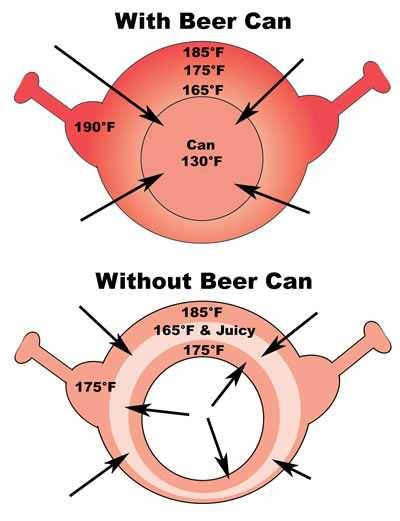
We love the flavor of browned meats. Browning happens when the amino acids and sugars in meat are heated past a certain point. It is called the Maillard reaction and it is the reason we love seared steaks, toasted bread, roasted coffee, and crispy chicken skin. By inserting a metal tube filled with liquid you prevent the inside of the chicken from browning, so you get less of the stuff we love best. But the methods I recommend will get you browned chicken all over, inside and out.
Worse, if you cook it at 325°F (163°C) on the indirect side of the grill, it is hard to get the skin brown and crisp unless you include sugar in the rub, and personally, I just don’t think roast chicken is at its best when sweetened. I think roast chicken is best savory, with an herbal rub.
The whole process can be dangerous.
- If you use just a plain old beer can, no fancy gadget, getting the bird and can off the grill is tricky. How do you grab it, by the can or by the bird? With what? And separating the two can be especially tricky because they are hot and they tend to stick together. Spill hot beer and fat on bare legs and feet in sandals and your July 4 will be spent in the emergency room.
- How’d you like some plastic in your hoofta? Brewers do not test the plastic liners inside the can at cooking temperatures, and the ink on the outside of the can is not likely food grade. I asked the folks at Anheuser-Busch, maker of Budweiser and other popular beers. They said “There are many recipes that cooks have been passing around for years that use beer to flavor chicken, and some of them suggest using an actual can of beer in the cooking process. While many people swear by these methods, and apparently they produce some delicious results, it’s not one we endorse or recommend, since we don’t design our cans for this purpose. We do, however, recommend many recipes using beer and for cooks to be creative with beer in many other dishes as well.” Some beers, like Guinness Stout, have a “widget”, a plastic ball in the can that helps release the nitrogen in the beer and who knows what it is made of and how it will behave when heated. Beware of widgets.
- Because the meat in the cavity is not heated from within, if you don’t use an accurate digital thermometer you run the risk of undercooked meat down in there. You must take the meat temp close to the ribs, not in the center of the breast as usual, because the coldest part is down by the cavity.
The final test
My wife and I tasted all the chickens we cooked in these experiments and paid especially close attention to the areas around the shoulder. We could find no trace of beer flavor. Dr. Blonder also tasted the birds he cooked side by side and found no beer flavor.
What others say
Doug Hanthorn, the very clever fellow behind TheNakedWhiz.com also set out to test the beer can chicken concept and came up with similar data. His conclusion? Same as ours.
Michael Chu, the author of the excellent website CookingForEngineers.com tested the Poultry Pal, a device that is supposed to improve on the beer can. He came to the same conclusion.
A really bad idea
Recently I have seen bloggers touting a variation on beer can chicken that Blonder calls “an unspeakably bad idea.” The idea is to use a bundt pan as a vertical roaster with vegetables in the pan. Says Blonder “It won’t speed up cooking, and the pile of vegetables and juices will create a low temperature sauna that steams instead of roasts the meat. Soggy skin and undercooked thighs. You’re better off with a Dutch oven.”
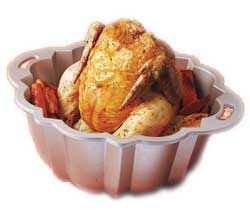
Seven ways to cook chicken better
By far the meat temp is the single most important factor in getting juicy, flavorful, safe chicken. The cooking method is less important. You want to remove the bird when the breasts are 165°F in the center (or against the ribs if you have a can in there). The dark meat should be about 170°F. Dark meat can withstand higher temps and you’ll hardly notice it, but overcook the breasts and you have cardboard. With all the money you can save on beer, buy yourself a good digital thermometer. Cutting the meat to look for clear juices is not reliable and the fact is that salmonella is widespread in poultry nowadays.
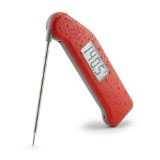
1) Whole bird roasted. If you just forego the can, lightly oil the entire bird, throw a hoofta of seasoning in the cavity so it actually is in contact with the meat, you will get a better bird. But it must be cooked on the indirect side, away from direct flame, in a 2-zone setup. If you want really crispy skin, as the meat approaches 150°F (65°C) you can then move it to the direct heat side and roll it around over high heat for a few minutes.
Blonder roasted a three pound chicken at 325°F (163°C), the temp I recommend for chicken and turkey. It is low enough to slowly cook the meat without badly overheating the outside layers, and high enough to render fat for crispy skin. He monitored the breast meat temp and the air temp in the cavity with highly accurate thermocouples.
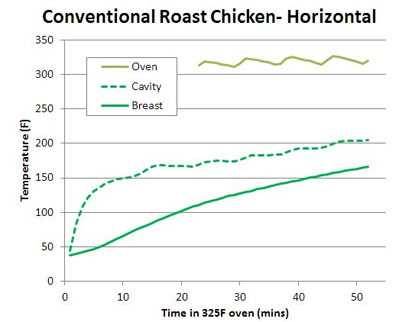
It took the meat just less than an hour to reach 165°F (75°C). By that time the air temp in the cavity was about 212°F (100°C), boiling temp for water. So by the time the bird was done, the air in the cavity was about 125°F (52°C) cooler than the air outside. The results were a bird that was “lightly brown and very moist and tender” on the outside, and pale on the inside.
2) Vertical roast. Blonder likes vertical roasting on the indirect side. “The one thing beer can chicken gets right is vertical roasting. This uniformly cooks the meat, and crisps the skin. As long as you monitor the temperature and catch it when the breast hits 165°F (75°C), the meat will be moist and tender. So I strongly recommend vertical wire roasting frames, on the grill or in the oven. And keep the beer where it belongs: In your hand.”
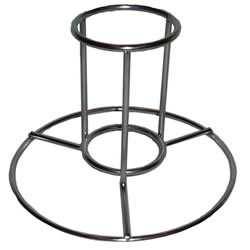
There are a number of gadgets that hold chickens upright on a wire rack. They work fine because air can enter the cavity and cook the meat on the inside. But the inside still doesn’t brown because the air gets trapped in there, and convection flow browns better. I recommend that if you use one of these you get a knife down into the neck cavity from above and open a “chimney” connecting to the abdominal cavity so hot air can travel through.
3) Rotisserie chicken is better still. Season the interior, and the juices from the rotating bird will roll around the skin but not as many will fall in. And you can put a pan under the bird with potatoes or veggies.

4) Spatchcocked or butterflied chicken is better still. You take the backbone out and flatten it and cook it skin up on the indirect side, and then flip it skin down on the direct side for a few minutes. This browns all parts on all sides, even the cavity. And it looks just as cool as Beer Can Chicken. The one at right was cooked on a gas grill. You can get really dark mahogany skin on a charcoal grill.

5) Halving the bird is better. Remember, these are animals, not widgets, and they never cook evenly. If you cut the bird in half you can use you trusty instant read thermometer and monitor doneness and move legs or breasts closer or further from the heat as needed. The fat also drains easily through the cut surfaces.
The problem with spatchcocking and halving is that the thighs easily tear off when you move the meat around since there is little other than skin holding it to the breasts.
6) Pieces kick Beer Butt Chicken in the butt. Cutting the bird into pieces is the best method, if you do it right. The secret is to set up a 2-zone configuration on your grill. This means one side, the direct heat side, is hot with the flame directly below, and the other side, the indirect heat side, has no flame below. You start the meat on the indirect side where it can gently roast from all sides at 225 to 325°F, and the bottom begins to brown. The indirect side cooks by circulating convection flow air. Put wood over the flames on the direct side and you can add another layer of flavor.
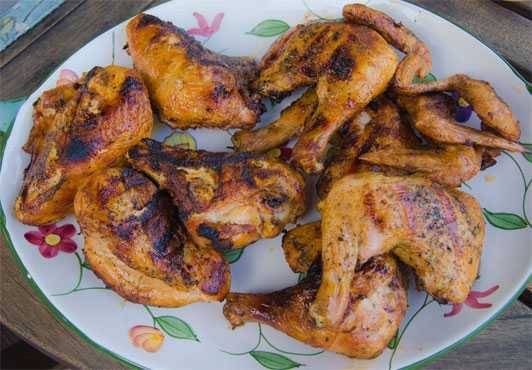
You can monitor each individual piece, and if you use a good digital thermometer you will be shocked to see how different they are. You can move each piece closer to or further from the direct heat so nothing overcooks. At about 150°F (65°C), you move each piece skin side down to the direct heat hot side and brown it. It is vital that you use the 2-zone system to make this work or the thin edges of the chicken will overcook and the meat will dry out.
Do it right and you will have tender, juicy pieces, brown all over, with each piece cooked to perfection, a feat impossible to achieve if the bird is whole and has a beer can up its butt.
Best of all, you don’t have to struggle cutting up a whole hot chicken.
7) The Weber way. Chef Matt Jost is the R&D Chef of the Weber Grill Restaurants (yes, Weber has three fun restaurants around Chicago and one in Indianapolis). He makes beer can chicken, but does some clever things that overcome some of the shortcomings of the normal method.
First, he brines the bird in a beer, spices, and salt for a day. He cautions, “Use lighter beers only, not stouts or porters.” Then he leaves only about 1 or 2″ (25 to 51 mm) of beer in the can, so most of the liquid is in the section of can protruding out of the chicken. That allows it to get hotter. Of course the dominant flavor is going to come from the brine, but you still get the drama of the bird on a can.
He also warns that you should let the can cool before trying to remove it. Interestingly, the restaurants serve “Beer Can Chicken kebabs” Which are beer marinated chicken on skewers. Methinks they know something…
How to cook chicken properly
Here’s a video of how to do a spatchcock chicken that is incredibly juicy with crispy skin, and brown in the cavity (and remember, brown is flavor).
Click here for my recipe for Simon & Garfunkel chicken, which describes this method in detail, and compare it to Beer Can Chicken. To do the comparison properly you must use the same rub on both preparations, and cook them side by side on the same grill monitoring temps with a digital thermometer.
Other tips to improve your chicken: Start by buying better birds, perhaps pasture raised, and then try brining, injecting, and smoking. Lay on the oil and herbs and steer clear of the sweet barbecue rubs.
But if you want to believe in Beer Can Chicken, please ignore the data and please ignore the logic and go ahead and waste your beer. And when you see a Michelin-rated restaurant offering Beer Can Chicken, please let me know.



High quality websites are expensive to run. If you help us, we’ll pay you back bigtime with an ad-free experience and a lot of freebies!
Millions come to AmazingRibs.com every month for high quality tested recipes, tips on technique, science, mythbusting, product reviews, and inspiration. But it is expensive to run a website with more than 2,000 pages and we don’t have a big corporate partner to subsidize us.
Our most important source of sustenance is people who join our Pitmaster Club. But please don’t think of it as a donation. Members get MANY great benefits. We block all third-party ads, we give members free ebooks, magazines, interviews, webinars, more recipes, a monthly sweepstakes with prizes worth up to $2,000, discounts on products, and best of all a community of like-minded cooks free of flame wars. Click below to see all the benefits, take a free 30 day trial, and help keep this site alive.
Post comments and questions below
1) Please try the search box at the top of every page before you ask for help.
2) Try to post your question to the appropriate page.
3) Tell us everything we need to know to help such as the type of cooker and thermometer. Dial thermometers are often off by as much as 50°F so if you are not using a good digital thermometer we probably can’t help you with time and temp questions. Please read this article about thermometers.
4) If you are a member of the Pitmaster Club, your comments login is probably different.
5) Posts with links in them may not appear immediately.
Moderators